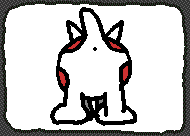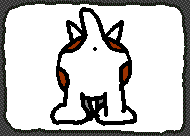AKC:
- The American Kennel Club is a PROFIT making company that is in business to register
dogs. The more dogs they register, the more money they make. They also oversee the competative
events such as hunting dog trials, obedience trials, agility trials, and confirmation shows to name a few, for
which they charge a fee. AKC's main business is to keep records. Records of Dogs, breedings, puppies,
shows, trials, etc. An AKC registration on your dog, does NOT, in anyway, proclaim or certify or guarantee
or imply that your dog is a QUALITY dog. It does not even guarantee that your dog is truly a purebred dog
or that the stated parents are really the parents of your dog. The AKC registration on your dog is only as
good as the people that you bought your dog from and in turn is only as good as the people that they
bought the mother and/or father from. How honest are the breeders of your puppy and the breeders of your
puppy's parents and grandparents? An AKC registration is similar to a US passport. A passport does not
say that you are a good person, a health person, an honest person. All a passport says is that you are
PROBABLY a US citizen.
BACKYARD vs. REPUTABLE BREEDERS:
- Backyard breeders are people that have no real reason or purpose for breeding other
than for money. In this day and age, there is no excuse for breeding to "see the miracle of birth" or so that
we can have one of Fluffy's puppies (what about the other 3-8 puppies in the litter, are they all going to have
great, loving, wonderful homes, or are they going to end up in the shelter within 2-3 years. Or worse, are
they going to end up dead on the road?) Some ways to tell if you are dealing with a backyard breeder:
You do not get a sales contract. You do not get a 4-5 generation pedigree. You do not get information
regarding housebreaking /training/ diet. A reputable breeder should "interview" you prior to your
purchasing a puppy. They should be concerned about your living environment and the people in the home.
They should be interested in your ability to spend quality time with the puppy and to properly care for all of
the puppy's needs, finacially and socially. They should be willing to say "I am sorry, I can not sell you a
puppy, because....." A reputable breeder should always be willing to take your puppy/dog back at any
time, for any reason. No reputable breeder wants to see any of his/her puppies end up in the
shelter/pound. Can your breeder tell you about the grandparents, great-grandparents, uncles, aunts,
cousins of your puppy? Can they show you pictures of these dogs. Can they tell you what these ancestors
died from? how old were they when they died? A reputable breeder will be able to do this. A reputable
breeder will be able to tell you and advise you about health concerns, yearly shots, wormings, fleas, ear
cropping and ear aftercare, recommend local vets. A reputable breeder should be willing to continue this
advise and consultation throughout the dogs life.
- COLOR:
- Boxers come in 3 basic colors, 2 that are AKC registerable colors. Fawn is a light tan to a dark reddish brown. Brindle is also a tan to dark brown, but with black stripes (tiger stripes).
Brindles can also be called reverse brindle or seal brindle if the black stripes are so thick that they almost cover the entire dog. This makes the boxer
appear to be "black". The third color of boxer is white. The white boxer is a problem in the boxer community. It is difficult to separate fact from folk lore; truth from old wives tales.
The American Boxer Club will not allow its members to breed or sell white boxers; they must be neutered or spayed; they can not be registered.
If you are thinking about purchasing or acquiring a white boxer, you must be aware that there is a high rate of deafness in white boxers. There is also a higher rate of
skin problems, diet problems and eye problems.
WHITE BOXERS SHOULD NOT BE USED FOR BREEDING
- FLASHY/PLAIN:
- Flashy refers to the amount of white that is on the dog. All boxers have some white on them. There is usually some
white on the toes, some white on the chest and belly. This would be referred to as a plain boxer. If it has white on it's face, a blaze up the center of it's nose and between the eyes, and or
if it has white socks and/or if it has white on the neck, then this would be considered flashy. Boxers are allowed to have as much as 1/3 of the body to be white, if it is going to be shown in
AKC conformation. The white markings should be attractive and even. White markings do NOT make a better dog. White markings are just that, markings. Just like pin stripping on a car.
- SIZE:
- The Boxer is a medium sized dog. The girls should be between 50 - 65 pounds when full grown. The boys should be
between 60-80 pounds. An 80 pound boxer is a BIG or fat boxer. The males should stand about 22.5 to 25 inches at the shoulder.
The girls should be 21 to 23.5 inches at the shoulder.
- GROOMING:
- Boxers do not require a lot of grooming. It is a good idea to set aside one day each month
for you to groom your boxer. At least once a month you should bath your boxer. The dog/pet shampoos
that are available today are very good. Call your local vet or pet groomer and ask what brand of shampoo
they would suggest. You should also clean your boxers ears out once a month. Use regular rubbing alcohol or you can use regular mouth wash.
Clean the ear out using a cotton ball. Another thing you should be able to do monthly is cutting your boxers toenails
We actually do not cut our boxers nails, we grind them using a DREMEL. A dremel is a small, hand held wood working tool
that has a variety of attachments including a grinding stone. WORKS GREAT. You can also "brush" your boxers teeth.
Actually you can purchase a doggy toothbrush and toothpaste at most pet stores. You can also use a rubber, fingertip, baby toothbrush
and regular, plain Hydrogen Peroxide. One thing you should remember -- it is a lot easier to start training your
boxer to take a "nice" bath, to have his toenails cut, and to brush his teeth, when they are puppies. Trying to
teach a full grown boxer to sit still while you do some of this can be quite the undertaking.
FOOD:
- Food is a very tricky and personal subject. There are many variables that can enter into
your dogs and your particular situation. Allergies, cost, availability, health, etc. In general I do not recommend your
general "grocery store" dog food. If you must try Pedigree. Better yet find a local pet supply store with a variety
of quality, premium dog foods to select from. VERY BASICLY, my requirements for a dog food are as follows.
Some type of meat should be the first ingredient. I prefer Lamb or Chicken. I then look at the ingredients list to see
if there is any soybean or soybean product/by-product. I HATE soybean in dog food. NO SOYBEAN. I am also
not a big fan of corn in dog food. I also do not want any food coloring or food dyes in the dog food. I do like dog
food that is preserved with Vitamin E and/or Vitamin C. I personally use Diamond Pet Food. I normally feed
my boxer puppies puppy food until they are about 4-5 months of age and then switch them to regular adult food.
SPAY/NEUTER:
- It is strongly suggested that you spay/neuter you pet Boxer. It is also suggested that
this be done as early as possible, usually by 6 months of age. Doing this at an early age is less expensive
for you and less traumatic for your pet. This will prevent numerous problems and
help your boxer live a longer, healthier life.
HOUSEBREAKING:
- We strongly suggest that before you purchase your Boxer puppy, that you first purchase a crate for
your new arrival. You can purchase a large crate and use dividers while your boxer is just a puppy. It is
suggested that the size of the crate or divided crate be just large enough for the dog to stand up, turn around
and lie down. The crate should not be large enough for the dog/puppy to "soil" the crate in one corner and
sleep in the other corner. You should have a small blanket or towel for the puppy to sleep on. A couple of
safe toys and a bucket of water hanging from the side of the crate. Do not put a bowel of water in the crate
for the puppy to go 'swimming' in. The puppy should be fed in the crate. Initially put the food at the rear of
the crate to get the puppy to go in. The crate is the puppy's den, his bedroom, his play room, and where you
send him when he has been bad. Just like a child being sent to his/her bedroom when they are bad.
In general the puppy should be in the crate when ever you can not supervise the puppy.
FENCES
- First off, I hate to chain a dog, any dog. We suggest that you fence your back yard. If this is not possible,
we suggest that you fence a portion or area of your back yard. You can use modular chain link fence that
is specifically made for this purpose and available at most larger home/hardware stores. The size can be
as small as 4 x 6 feet or 12 x 20 feet by 6 feet high or anywhere in between. If you are going to fence your back
yard, I would suggest again 6 foot high chain link fence, but wood is also fine. I am not a big fan of the underground
invisible type fence. Boxers in general have a very high tolerance of pain. If a boxer is in full chase after a
rabbit, cat, or boy on a bicycle, no shock or sound is going to stop him. Also, if your girl boxer is in season,
the invisible fence is not going to keep out other boy dogs.
Second, no dog should be allowed to spend long periods of time outside, unsupervised. There are too
many nasty, mean, bad people out there. Also your barking dog may be unwelcome by your sleeping neighbor.
In addition. boxer can and will find a way out of almost anything. They can jump, climb, dig, or just generally
break out of just about any confined area.
|






